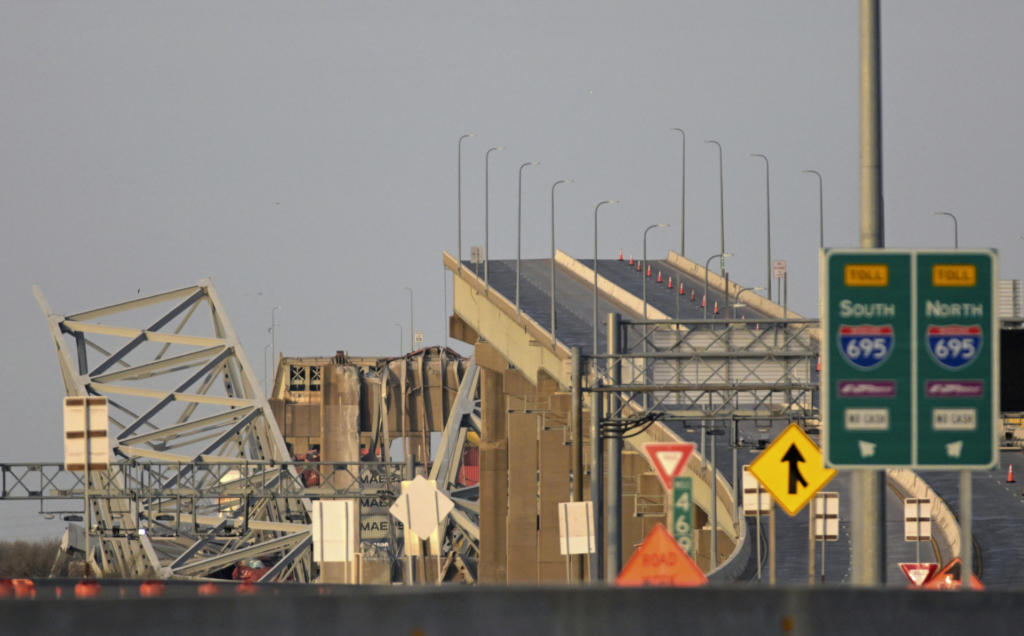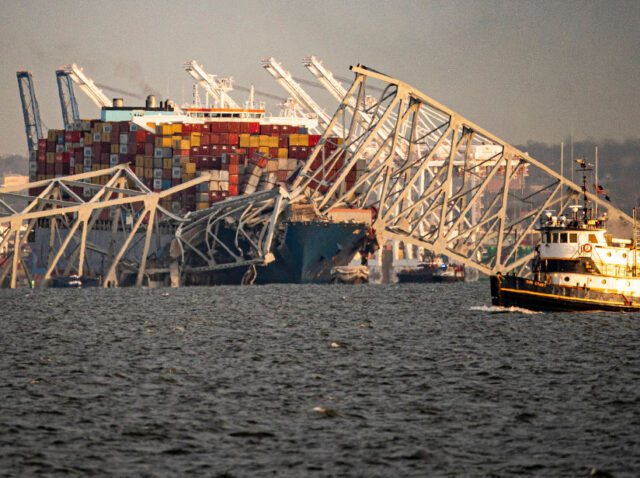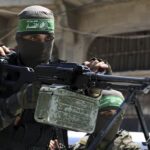The major Beltway Bridge over the Patapsco River has collapsed after being hit by a large cargo ship, sending vehicles travelling on the bridge tumbling into the water.
A four-lane bridge carrying the Interstate-695 over the mouth of Baltimore harbour collapsed in the early hours of Tuesday morning, around 0130 EST (0530GMT). Baltimore Mayor Brandon M. Scott has said he is aware of an “incident at the Key Bridge” and that emergency services are on scene.
UPDATE 0915EST — Ship ‘lost propulsion’
As reported at length earlier, it was clear there were serious problems aboard the MV Dali in the minutes before it collided with the Beltway Bridge, with onboard power going out four minutes before impact, plunging the ship into darkness. Now the BBC notes “an unclassified memo” from the U.S. Cybersecurity & Infrastructure Security Agency (CISA) states it has confirmed the ship “lost propulsion” before hitting the bridge.
So evidently the ship was, as nautical parlance has it, ‘not under command’, meaning “at the mercy of winds and seas” — and in this case, inertia. What we do not know is whether this state of having “lost propulsion” means the engine ceased to function, or if the coupling taking the energy from the engine to the propeller was damaged. In either case the ship was disabled at a critical moment and in a critical place and collided with enormous force.
A bridge engineer speaking to Breitbart News today said the bridge suffered a “catastrophic failure” after being struck but this isn’t exactly the fault of the bridge. The amount of energy embodied in a moving container ship weighing over 110,000 tons full laden is enormous and fortifying a large bridge against that kind of impact is essentially beyond what material science is capable of.
The search for survivors continues, but the cold water presents a serious challenge. One person in in hospital and two others are said by the Baltimore fire department to have been rescued. Up to a dozen others — mainly from the road repair crew working on the bridge at the time of the strike — may still be in the water.


UPDATE 0800EST — Pictures from the scene
While we’ve had livestream footage from the scene all morning, photographers have been slow to get a view of the damage at the mouth of the Port of Baltimore. Here are the best so far, illustrating the enormous level of damage caused, blocking the river.
The original story continues below
The Baltimore Fire Department says the collision, which saw several vehicles which were travelling on the bridge plunge into the Patapsco River, is a ” developing mass casualty event”. Department director of communications Kevin Cartwright told the Associated Press: “This is a dire emergency… Our focus right now is trying to rescue and recover these people.”
The crew of the ship and the two pilots aboard — port authority professional navigators who help bring large ships in and out safely — are unharmed.
Livestream footage of the river shows a large container ship, identified as the Singapore-flagged container ship MV Dali, striking head-on one of the piers supporting the central span of the bridge. This immediately brings down that central span and the southward span towards Fort Armistead. Just a moment later, the northward span, left unbalanced by the loss of the centre, also collapses.
Realtime marine traffic data from the port of Baltimore shows the MV Dali is still broadcasting by its automatic identification system transceiver that it is “underway using engine”, which may indicate if a machinery failure caused the ship to drift out of the channel and into the bridge piles, it was not detected by onboard systems which are supposed to be automatic. Several rescue craft including Baltimore Fire Department boats are around the bridge.
A livestream video provided by local businesses and hosted on YouTube seen by Breitbart London shows the lead-up to the collision and the moment of impact. Amber flashing beacons on the central span of the bridge show what is reported to be construction crews working on the structure late into the night, while light traffic including cars and tractor-trailer trucks cross on the open lanes.
In a strike of blind luck, the moment the ship hits the bridge and it collapses, passing traffic appears to be very light compared to the number of cars and trucks present on the bridge just minutes earlier.
The MV Dali approaches from the north-east but approximately four minutes and 20 seconds before impact all lights aboard the ship go out, a clear indication of a total onboard loss of power. One minute and ten seconds after this visual indication that all is not well onboard some lights are restored, and they continue to turn on and off to varying degrees until the collision.
During these last minutes, the MV Dali turns sharply — particularly for a ship of its size — to starboard, putting it on course for the bridge support. From three minutes until impact until the strike a very large plume of thick, dark smoke appears to pour from the ship’s chimney, indicative of either the engine working very hard or a fire onboard. In the case of the crew being aware of the imminent disaster and attempting to prevent the collision, the volume of smoke would likely mean failed engines being restarted or — if already running after the total electrical failure — the engines being put under a high load to slow the ship down.
The potential disruption from this incident is potentially enormous. Quite apart from the severing of the I-695 across the Patapsco River — several other bridges cross further upstream, at the risk of carrying more traffic through the city itself — the port of Baltimore will likely be blocked for an extended period while the wreckage of the large bridge in the dredged channel capable of taking large ship traffic is cleared.
Per a February local news report, the Port of Baltimore set new records in the amount of cargo it was handling, amounting to some 52.3 million tons of foreign cargo imported at a value of $80.8 billion. The port is large enough to handle the largest container ships in the world, including the Evergreen A-class.
The MV Dali, which struck the Baltimore bridge today, carries an equivalent of of 9,962 twenty-foot shipping containers, which the port handled 1.1 million of last year. The port is also a major centre for the car industry, and handled 847,158 cars and light trucks in 2023, which was said to be “more cars and light trucks than any other U.S. port for 13 consecutive years”.


